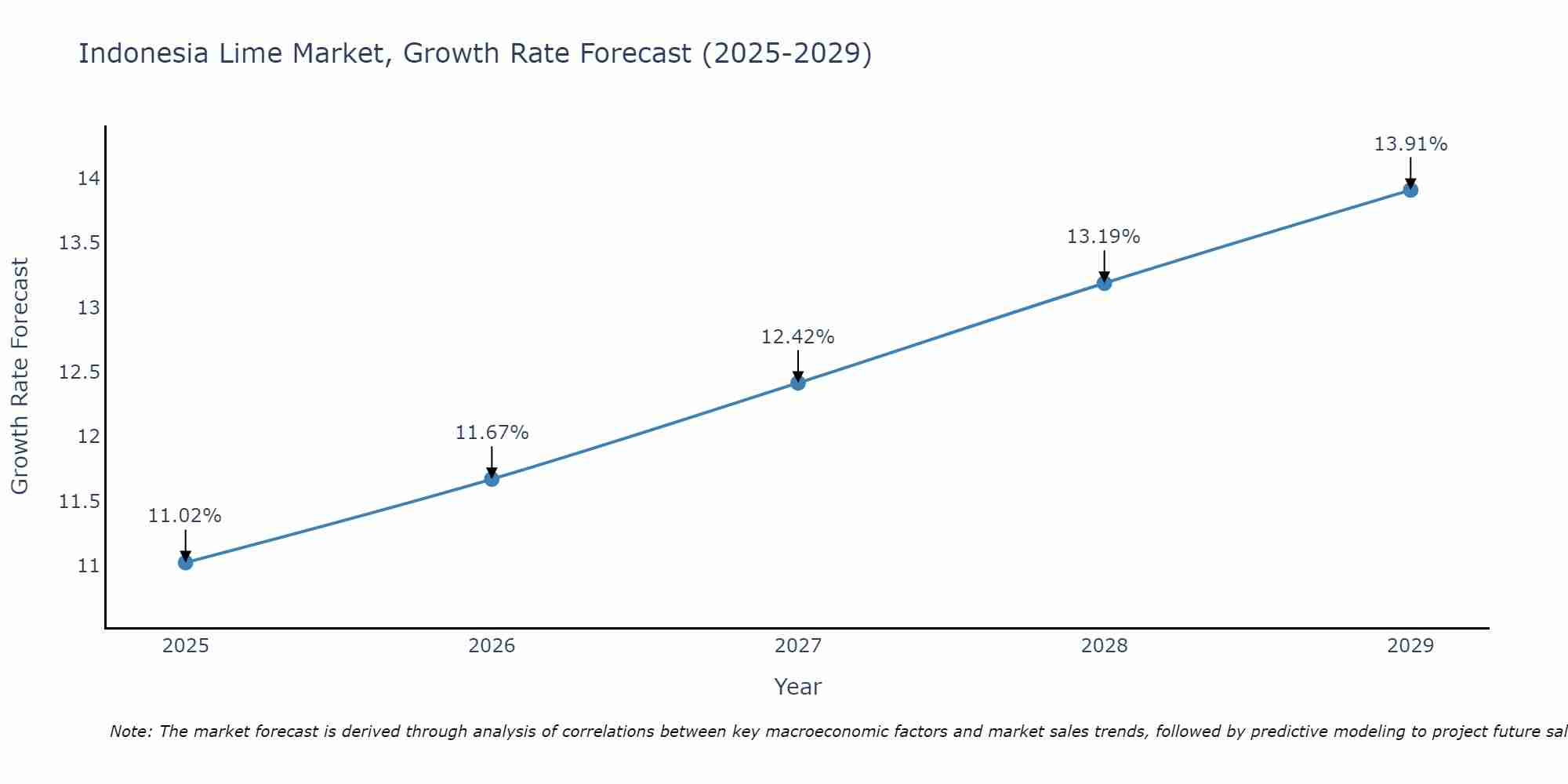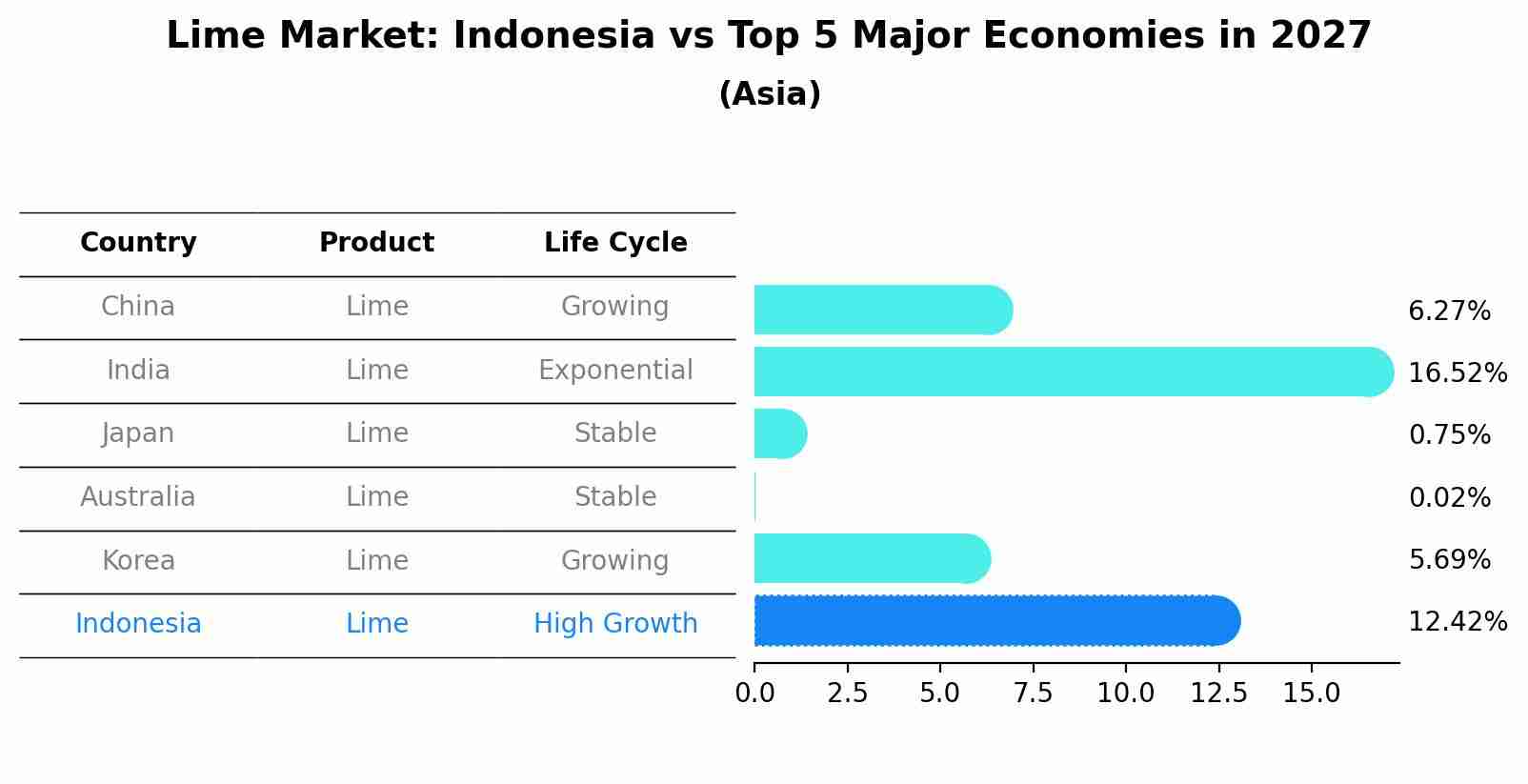Indonesia Lime Market (2025-2031) | Analysis, Companies, Size, Revenue, Value, Trends, Growth, Share, Outlook, Industry, Forecast
| Product Code: ETC008328 | Publication Date: Jul 2023 | Updated Date: Apr 2025 | Product Type: Report | |
| Publisher: 6Wresearch | No. of Pages: 70 | No. of Figures: 35 | No. of Tables: 5 | |
Indonesia Lime Market Size Growth Rate
The Indonesia Lime Market is likely to experience consistent growth rate gains over the period 2025 to 2029. From 11.02% in 2025, the growth rate steadily ascends to 13.91% in 2029.

Lime Market: Indonesia vs Top 5 Major Economies in 2027 (Asia)
By 2027, the Lime market in Indonesia is anticipated to reach a growth rate of 12.42%, as part of an increasingly competitive Asia region, where China remains at the forefront, supported by India, Japan, Australia and South Korea, driving innovations and market adoption across sectors.

Indonesia Lime Market Synopsis
The Indonesia lime market is expected to witness substantialin theperiod of 2025-2031 owing to increasing demand from various end-user industries such as food and beverage cosmetics manufacturing pharmaceuticals and other sectors. The rising health awareness among consumers across the country has led to an increased consumption of limes for its medicinal properties. In addition factors such as a rise in population coupled with rapid urbanization are also projected to drive theof thisover the coming years. Furthermore government initiatives towards promoting organic farming are likely to create lucrative opportunities for producers operating in this space.
Drivers of the Market
1) Increasing Demand from End-User Industries: The growing demand for limes from various end user industries like food and beverage processing sector is one of the major factors driving theof Indonesia lime market. Limes are used widely by hotels and restaurants worldwide as they impart a distinct flavor to dishes which increases their popularity amongst customers. This has further encouraged businesses involved in these activities to increase their procurement volumes resulting into higher sales figures for producers operating within this space. 2) Rise in Health Awareness Among Consumers: Another factor fueling upwithin Indonesia lime market is rising health consciousness amongst consumers across different age groups who prefer consuming fresh fruits rather than canned ones due its numerous benefits regarding health management options available naturally through them. Rising awareness regarding hygiene standards has prompted many households towards procuring organically grown products including limes which have further created new avenues orgeneration within this sector too contributing significantly towards overall expansion witnessed here recently.
Challenges Faced by the Market
1) High Cost Involved in Distribution Network : One key challenge faced by manufacturers operating within Indonesia limeis that cost involved with setting up distribution networks often tend be very high making it difficult for small players especially those based outside large cities/towns where availability resources may not always be sufficient enough or beneficial . Such firms usually suffer more when compared larger counterparts while catering local markets since transportation costs associated become much higher along with additional expenses required maintaining warehouses etc making it hard them compete effectively against larger competitors without compromising margins earned substantially. 2) Lack Skilled Labour Force : Another important issue encountered by participants present this marketplace lack skilled labour force needed efficiently run operations particularly producing high quality produce meeting international standards set forth . While number workers employed increased during recent times still remains inadequate meet demands generated through rapidly expanding customer base thus creating serious problems regards efficient functioning.
Key Highlights of the Report:
- Indonesia Lime Market Outlook
- Market Size of Indonesia Lime Market, 2024
- Forecast of Indonesia Lime Market, 2031
- Historical Data and Forecast of Indonesia Lime Revenues & Volume for the Period 2021-2031
- Indonesia Lime Market Trend Evolution
- Indonesia Lime Market Drivers and Challenges
- Indonesia Lime Price Trends
- Indonesia Lime Porter's Five Forces
- Indonesia Lime Industry Life Cycle
- Historical Data and Forecast of Indonesia Lime Market Revenues & Volume By Product Type for the Period 2021-2031
- Historical Data and Forecast of Indonesia Lime Market Revenues & Volume By Quick Lime for the Period 2021-2031
- Historical Data and Forecast of Indonesia Lime Market Revenues & Volume By Hydrated Lime for the Period 2021-2031
- Historical Data and Forecast of Indonesia Lime Market Revenues & Volume By Applications for the Period 2021-2031
- Historical Data and Forecast of Indonesia Lime Market Revenues & Volume By Agriculture for the Period 2021-2031
- Historical Data and Forecast of Indonesia Lime Market Revenues & Volume By Building Material for the Period 2021-2031
- Historical Data and Forecast of Indonesia Lime Market Revenues & Volume By Mining and Metallurgy for the Period 2021-2031
- Historical Data and Forecast of Indonesia Lime Market Revenues & Volume By Water Treatment for the Period 2021-2031
- Historical Data and Forecast of Indonesia Lime Market Revenues & Volume By Others for the Period 2021-2031
- Indonesia Lime Import Export Trade Statistics
- Market Opportunity Assessment By Product Type
- Market Opportunity Assessment By Applications
- Indonesia Lime Top Companies Market Share
- Indonesia Lime Competitive Benchmarking By Technical and Operational Parameters
- Indonesia Lime Company Profiles
- Indonesia Lime Key Strategic Recommendations
Frequently Asked Questions About the Market Study (FAQs):
1 Executive Summary |
2 Introduction |
2.1 Key Highlights of the Report |
2.2 Report Description |
2.3 Market Scope & Segmentation |
2.4 Research Methodology |
2.5 Assumptions |
3 Indonesia Lime Market Overview |
3.1 Indonesia Country Macro Economic Indicators |
3.2 Indonesia Lime Market Revenues & Volume, 2021 & 2031F |
3.3 Indonesia Lime Market - Industry Life Cycle |
3.4 Indonesia Lime Market - Porter's Five Forces |
3.5 Indonesia Lime Market Revenues & Volume Share, By Product Type, 2021 & 2031F |
3.6 Indonesia Lime Market Revenues & Volume Share, By Applications, 2021 & 2031F |
4 Indonesia Lime Market Dynamics |
4.1 Impact Analysis |
4.2 Market Drivers |
4.3 Market Restraints |
5 Indonesia Lime Market Trends |
6 Indonesia Lime Market, By Types |
6.1 Indonesia Lime Market, By Product Type |
6.1.1 Overview and Analysis |
6.1.2 Indonesia Lime Market Revenues & Volume, By Product Type, 2021-2031F |
6.1.3 Indonesia Lime Market Revenues & Volume, By Quick Lime, 2021-2031F |
6.1.4 Indonesia Lime Market Revenues & Volume, By Hydrated Lime, 2021-2031F |
6.2 Indonesia Lime Market, By Applications |
6.2.1 Overview and Analysis |
6.2.2 Indonesia Lime Market Revenues & Volume, By Agriculture, 2021-2031F |
6.2.3 Indonesia Lime Market Revenues & Volume, By Building Material, 2021-2031F |
6.2.4 Indonesia Lime Market Revenues & Volume, By Mining and Metallurgy, 2021-2031F |
6.2.5 Indonesia Lime Market Revenues & Volume, By Water Treatment, 2021-2031F |
6.2.6 Indonesia Lime Market Revenues & Volume, By Others, 2021-2031F |
7 Indonesia Lime Market Import-Export Trade Statistics |
7.1 Indonesia Lime Market Export to Major Countries |
7.2 Indonesia Lime Market Imports from Major Countries |
8 Indonesia Lime Market Key Performance Indicators |
9 Indonesia Lime Market - Opportunity Assessment |
9.1 Indonesia Lime Market Opportunity Assessment, By Product Type, 2021 & 2031F |
9.2 Indonesia Lime Market Opportunity Assessment, By Applications, 2021 & 2031F |
10 Indonesia Lime Market - Competitive Landscape |
10.1 Indonesia Lime Market Revenue Share, By Companies, 2024 |
10.2 Indonesia Lime Market Competitive Benchmarking, By Operating and Technical Parameters |
11 Company Profiles |
12 Recommendations |
13 Disclaimer |
- Single User License$ 1,995
- Department License$ 2,400
- Site License$ 3,120
- Global License$ 3,795
Search
Related Reports
- Portugal Occupational Health & Safety Services Market (2025-2031) | Strategy, Consumer Insights, Analysis, Investment Trends, Opportunities, Growth, Size, Share, Industry, Revenue, Segments, Value, Segmentation, Supply, Forecast, Restraints, Outlook, Competition, Drivers, Trends, Demand, Pricing Analysis, Competitive, Strategic Insights, Companies, Challenges
- Netherlands Occupational Health and Safety Services Market (2025-2031) | Strategy, Consumer Insights, Analysis, Investment Trends, Opportunities, Growth, Size, Share, Industry, Revenue, Segments, Value, Segmentation, Supply, Forecast, Restraints, Outlook, Competition, Drivers, Trends, Demand, Pricing Analysis, Competitive, Strategic Insights, Companies, Challenges
- Belgium and Luxembourg Facility Management Market (2025-2031) | Strategy, Consumer Insights, Analysis, Investment Trends, Opportunities, Growth, Size, Share, Industry, Revenue, Segments, Value, Segmentation, Supply, Forecast, Restraints, Outlook, Competition, Drivers, Trends, Demand, Pricing Analysis, Competitive, Strategic Insights, Companies, Challenges
- Russia Women Intimate Apparel Market (2025-2031) | Strategy, Consumer Insights, Analysis, Investment Trends, Opportunities, Growth, Size, Share, Industry, Revenue, Segments, Value, Segmentation, Supply, Forecast, Restraints, Outlook, Competition, Drivers, Trends, Demand, Pricing Analysis, Competitive, Strategic Insights, Companies, Challenges
- Africa Chocolate Market (2025-2031) | Size, Share, Trends, Growth, Revenue, Analysis, Forecast, industry & Outlook
- Global Hydroxychloroquine And Chloroquine Market (2025-2031) | Industry, Trends, Size, Outlook, Growth, Value, Companies, Revenue, Analysis, Share, Forecast
- Saudi Arabia Plant Maintenance Market (2025-2031) | Industry, Size, Growth, Revenue, Value, Companies, Forecast, Analysis, Share & Trends
- Taiwan Electric Truck Market (2025-2031) | Outlook, Industry, Revenue, Size, Forecast, Growth, Analysis, Share, Companies, Value & Trends
- South Korea Electric Bus Market (2025-2031) | Outlook, Industry, Companies, Analysis, Size, Revenue, Value, Forecast, Trends, Growth & Share
- Africa Low Temperature Powder Coating Market (2025-2031) | Companies, Competition, Size, Challenges, Segmentation, Trends, Competitive, Industry, Supply, Strategy, Investment Trends, Growth, Segments, Restraints, Strategic Insights, Revenue, Share, Forecast, Drivers, Analysis, Pricing Analysis, Demand, Consumer Insights, Value, Opportunities, Outlook
Industry Events and Analyst Meet
Our Clients
Whitepaper
- Middle East & Africa Commercial Security Market Click here to view more.
- Middle East & Africa Fire Safety Systems & Equipment Market Click here to view more.
- GCC Drone Market Click here to view more.
- Middle East Lighting Fixture Market Click here to view more.
- GCC Physical & Perimeter Security Market Click here to view more.
6WResearch In News
- Doha a strategic location for EV manufacturing hub: IPA Qatar
- Demand for luxury TVs surging in the GCC, says Samsung
- Empowering Growth: The Thriving Journey of Bangladesh’s Cable Industry
- Demand for luxury TVs surging in the GCC, says Samsung
- Video call with a traditional healer? Once unthinkable, it’s now common in South Africa
- Intelligent Buildings To Smooth GCC’s Path To Net Zero













